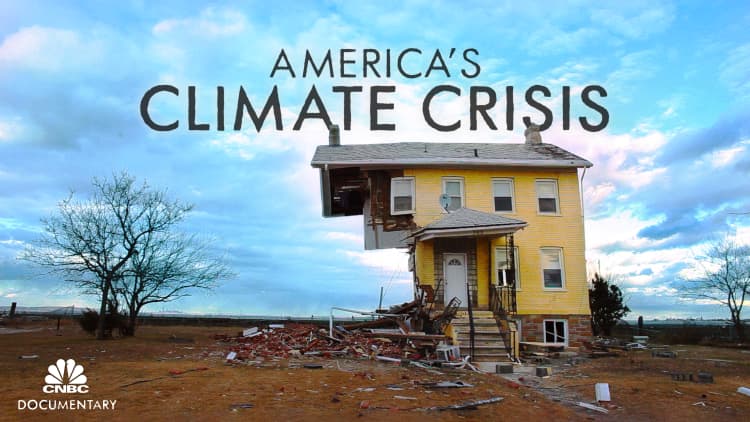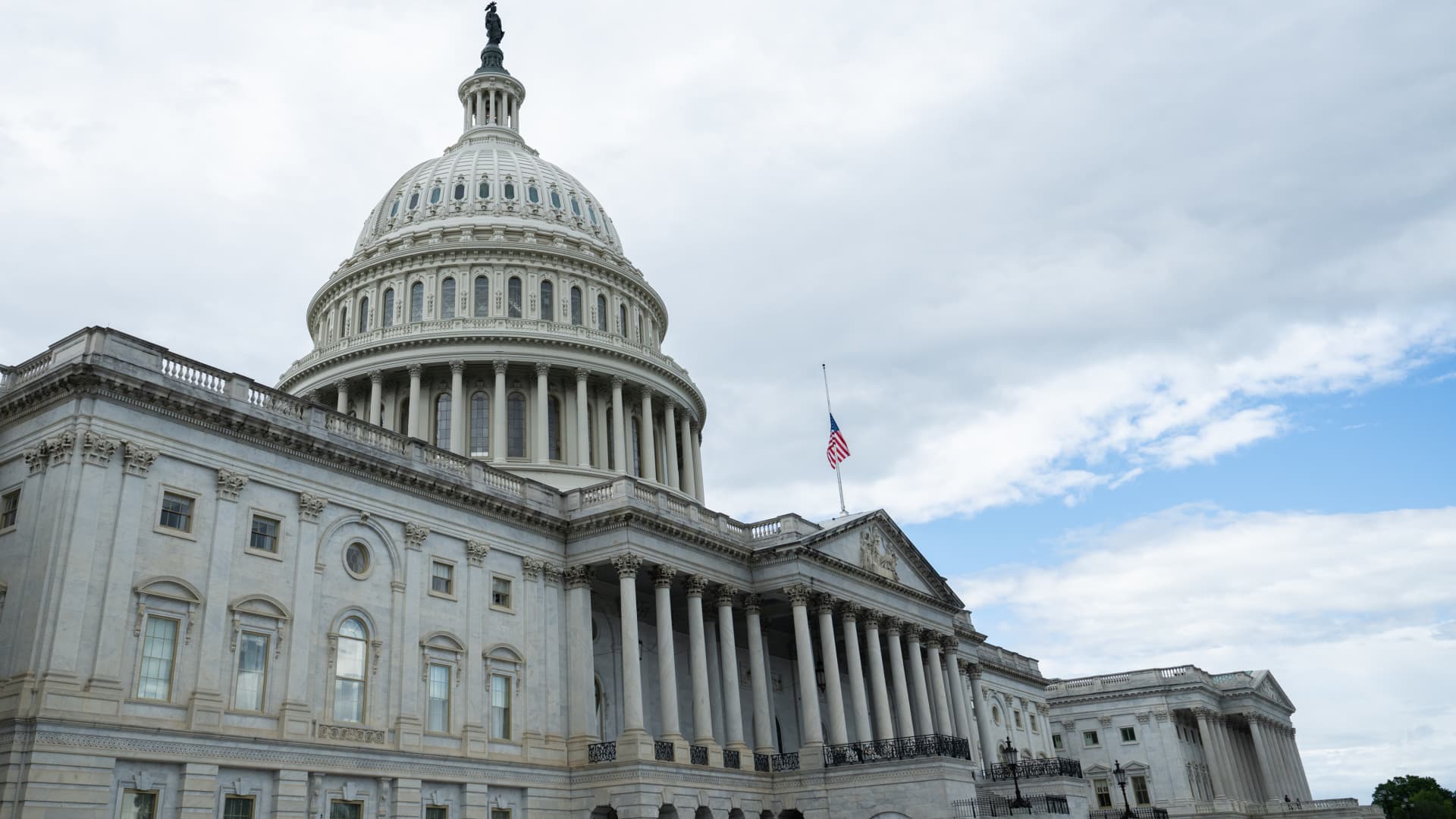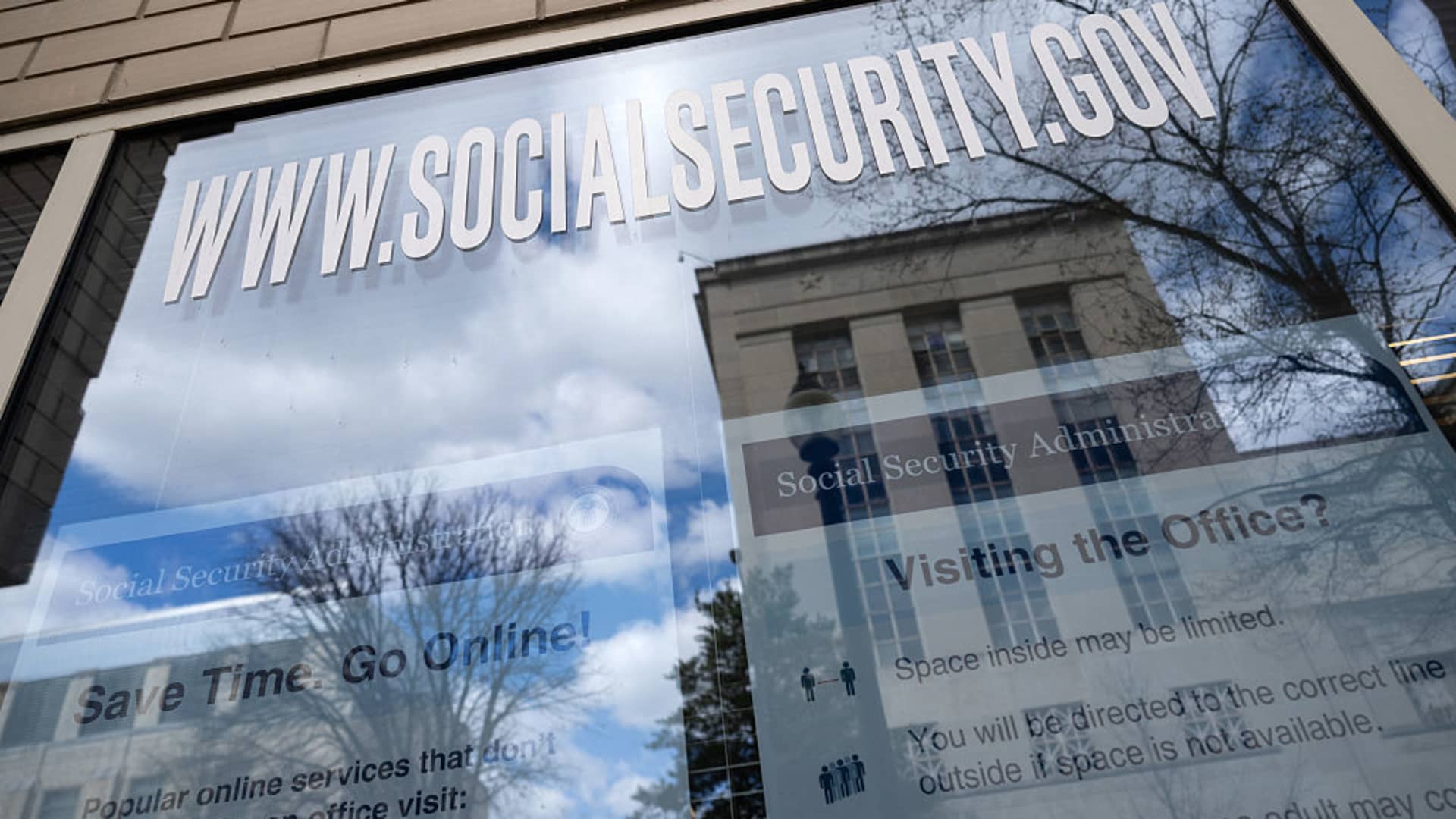Personal Finance
Miami is ‘ground zero’ for climate risk. People move there, build there anyway
Published
1 year agoon

South Pointe Beach in Miami Beach, Florida.
Greg Iacurci
MIAMI — Daniel Habibian worries about climate change.
His clothing boutique in Miami Beach’s iconic South Beach neighborhood sits just a few blocks inland from the Atlantic Ocean.
Rising seas threaten to swallow much of the Miami metro area in the coming decades as the world continues to warm and faraway ice sheets melt. By 2060, about 60% of Miami-Dade County will be submerged, estimates Harold Wanless, a professor of geography and sustainable development at the University of Miami.
Yet people keep moving there. The city’s skyline has grown in tandem.
Miami’s boom runs headlong into a harsh yet inescapable truth: It’s “ground zero for climate change,” said Sonia Brubaker, chief resilience officer for the City of Miami.
Climate risk is “always on our thoughts,” said Habibian, 39, who moved to Miami-Dade County about six years ago.
Daniel Habibian stands outside his store, Studio 26, a clothing boutique in South Beach.
Greg Iacurci
“[Miami] is almost at sea level, so a bit of water can take it underwater,” he told CNBC inside his store, Studio 26.
Outside, sun-kissed tourists and locals trickled by on their way back from the nearby ocean as reggaeton pulsed from flashy convertibles. The March air, a perfect 75 degrees, mixed with a gentle breeze that caressed palm fronds and passersby in a warm embrace.
Such weather is what drew Habibian to the area from New York.
“We like living here,” he said. “So we’ll see what happens.”
More people ‘moving into risky areas’ than leaving
The Miami metro area — including Miami, Fort Lauderdale and West Palm Beach — is a low-lying swath of South Florida that is home to more than 6 million people.
Its urban sprawl juts abruptly from the Atlantic shoreline like a vertical spike of glass, metal and concrete.
Construction volume in the greater Miami metro area hit $27.4 billion in 2023, up 73% from $15.8 billion in 2014, according to an analysis by Cumming Group, a project management and cost consulting firm.
It projects that those values, which are adjusted for inflation, will rise to about $29 billion in 2024 and 2025.
The Miami area population has also ballooned, growing by more than 660,000 people from 2010 to 2020 — the most of any other Florida metropolis and nearly twice the tally of No. 2 Tampa-St. Petersburg, according to the Florida Department of Transportation.
The Bentley Residence condominium complex, center, under construction in Miami, Florida, in September 2022.
Saul Martinez/Bloomberg via Getty Images
The trend shows how many Americans are ultimately willing to overlook environmental risks, even though most acknowledge its presence — a choice that could later devastate them financially.
Across the U.S., people are still moving into areas increasingly prone to natural disasters, according to Andrew Rumbach, a senior fellow at the Urban Institute.
“We have a lot more people moving into risky areas than moving out, which is kind of counterintuitive,” Rumbach said.
The contradictory forces at play in Miami foreshadow the financial hardship many other Americans will likely face, too.
Rising seas and a sinking city
A flooded street in Miami after a tropical storm in June 2022. The system dumped at least six to 10 inches of rain in the area.
Joe Raedle | Getty Images News | Getty Images
Miami’s average elevation is six feet — the same amount of sea-level rise expected in Southeast Florida by the end of the century. The ocean has already risen by about six inches since 2000.
The city is simultaneously sinking. It sits on porous limestone rock, which some engineers have likened to Swiss cheese; in other words, water can easily seep from underground.
These dynamics exacerbate flooding from rising seas, storm surge, torrential rains and so-called “king tides,” which are periodic exceptionally high tides. The frequency of flooding from high tides — known as “sunny day” flooding — is up over 400% in Miami Beach since 2006.
Researchers at the Organisation for Economic Co-operation and Development listed Miami as one of the 10 most vulnerable cities worldwide relative to the number of people at risk of coastal inundation. It’s the most vulnerable when judged by the total value of assets such as buildings and infrastructure at risk.
Meanwhile, Miami residents are also confronted by more extreme heat and intensifying storms such as hurricanes, experts said.
Volunteers clear debris from a Florida Keys home damaged by a six-foot storm surge during Hurricane Irma.
Al Diaz/Miami Herald/Tribune News Service via Getty Images
The financial threats of such climate disasters are numerous: property damage, higher insurance premiums and medical bills, lost earnings, falling real estate values, declining tourism, forgone business profits and displacement costs such as temporary housing or relocation, among others.
Despite that risk, 66% of Miami-Dade County residents said they’d never leave, according to a study published in the journal Climate Risk Management.
It is not that they deny climate change: More than three-quarters, 77%, of Miami-Dade County residents say global warming is happening, 5 percentage points above the 72% national average, according to a poll by Yale University’s School of the Environment.
More from Personal Finance:
Why climate change may cost you big bucks
What the SEC vote on climate disclosures means for investors
8 easy — and cheap — ways to cut your carbon emissions
“I do believe we’re going to be in danger of losing land in the near future — maybe 50 years, 100 years — because of sea-level rise,” said Steven Bustamante, 32, a Miami Beach resident.
But it’s not something that would push him to leave.
Bustamante, who works at a market in South Beach, has lived here all his life and loves the subtropical climate.
In multiple street interviews CNBC conducted with Miami residents, weather was almost universally cited as the top draw.
“I wouldn’t leave,” Bustamante said. “I wouldn’t leave for anything.”
CEO says Miami is the ‘future of America’
Jeff Greenberg | Universal Images Group | Getty Images
The “breakneck pace” at which high-rise condos, hotels and offices have popped up has quickly made Miami’s skyline “one of the largest and tallest in the country,” according to Cumming Group.
Miami still has the feel of a city under construction as developers scramble to meet housing demand. Cranes pepper the horizon next to the hollow husks of future high rises.
The City of Miami issued roughly 10 permits to build new residential and mixed-use buildings in 2014, according to a CNBC analysis of city data. By 2019, that figure had ballooned to more than 150 — an increase of well over 1,000%.
“There’s been a fairly strong development boom for quite some time,” said David Arditi, a founding partner of Aria Development Group, a residential real estate developer.
The Covid-19 pandemic “turbocharged” the city’s growth, said Arditi, who leads Aria’s Miami office.
The number of people who moved to the Miami metro area increased by nearly 60% between 2019 and 2022, more than any other major U.S. metro hub, according to the National Association of Realtors.
Office workers in the financial district of downtown Miami, Florida.
Saul Martinez/Bloomberg via Getty Images
With the freedom to work from anywhere, many people sought out better quality of life, including warm weather, relatively low taxes and ample job opportunity, Arditi said from Aria’s sales office for 2200 Brickell, a new residential building slated for completion around early 2026. Half of its 105 available condos are already sold. Prices start at $1 million.
A large share of recent migration is from California, New York and New Jersey, relatively high-tax states, according to a Miami Realtors analysis.
“Climate is only one thing people are thinking about when they’re making these decisions,” said Rumbach, of the Urban Institute.
In hot spots such as Miami, shorter-term interests can trump climate risk, he said.
Billionaires such as Amazon founder Jeff Bezos and Goldman Sachs Managing Director Douglas Sacks have relocated to Miami in recent years. Companies such as Citadel, a financial firm, and SH Hotels & Resorts also recently moved their global headquarters to the city, known as a “gateway” to Latin America and the Caribbean.
Ken Griffin, Citadel’s billionaire CEO, told Bloomberg News in November that Miami “represents the future of America.”
Such company and worker relocations have helped boost the local economy, said Brubaker, the city official.
Miami-Dade County’s 1.6% unemployment rate in February 2024 is near its lowest on record and is substantially lower than the national average of 3.9% that month.
“And you know, people get to enjoy year-round, beautiful weather,” Brubaker added. “Unless there’s a disaster.”
‘I hope the city doesn’t disappear’
Contractors work at a Miami office tower under construction in September 2022.
Saul Martinez/Bloomberg via Getty Images
Downtown Miami will soon host the tallest residential building south of New York City — the Waldorf Astoria Hotel and Residences, a 100-story monolith under construction on the shore of Biscayne Bay. Miami Worldcenter, a forthcoming 27-acre mixed-use complex, will be the second-largest urban development in the U.S. behind New York City’s Hudson Yards.
Developers and city officials tell CNBC they think a booming city can continue to thrive alongside climate change.
They tout Miami’s stringent building codes and infrastructure enhancements — such as higher elevation and more permeable ground for new construction, and higher roads and sea walls — as evidence of its resilience.
The City of Miami has a $400 million bond dedicated to investing in climate resilience projects.
“The city actively plans for it,” said Brubaker, who became the City of Miami’s chief resilience officer in 2022. “There’s a lot of preparation going into this.”
South Pointe Park in the City of Miami Beach is a green buffer between the water and the South of Fifth neighborhood.
Greg Iacurci
But some scientists and other experts see a misalignment when it comes to developers’ interests: Are they capitalizing on today’s hot real estate market with short-term investments and planning to offload properties before climate change threatens their long-term value? In that case, condo owners and other buyers may be left holding the bag.
From start to finish, Aria typically exits its real-estate projects after about five years, for example, said Arditi. It depends on the building — condominium projects may be on the short end of that range, while multifamily rentals are generally longer-term, he said.
“We try to be smart about it, try to be proactive as best we can,” Arditi said of climate risk. “It’s clearly top of mind.”
“But I hope the city doesn’t disappear anytime soon,” he added.
Rain storms can induce ‘trauma’
A woman walks in flooded water during a heavy rainfall in Miami on May 26, 2020.
Chandan Khanna | Afp | Getty Images
The risks of climate change are already a part of life in Miami.
“Every time it rains, I basically suffer a bit of a trauma,” said Dion Williams, a clothing designer with a storefront on Collins Avenue in South Beach, close to Habibian’s shop.
Williams moved to Miami eight years ago. His business, Dion Atelier, is on the ground floor a few streets from the ocean.
During big rain storms “the swell comes up, and the first thing that happens is the whole entire floor terrace floods,” said the proprietor, standing amid neatly styled displays and mannequins draped in high-end fashion.
Sometimes, the flooding is so bad it’s “almost like a lake,” Williams said.
He pointed out sections of the baseboard that had to be ripped out and replaced. Just an inch of flood water can cause $25,000 of property damage, according to the Federal Emergency Management Agency.
Now, as a precaution, Williams covers his merchandise in plastic when it rains.

About 70% of the 597 Miami-Dade County residents polled for a study published in the Climate Risk Management journal experienced rainfall-related flooding between 2017 and 2022, about 60% were affected by floodwater from hurricanes and tropical storms, and 16% were affected by tidal flooding.
The financial impacts were broad. Among them, 34% couldn’t commute to work, a dynamic that can reduce household earnings, experts said.
About 22% said their property and car insurance rates increased. Average property-casualty insurance premiums in the Sunshine State have risen to more than $4,200 a year, triple the national average, according to the Insurance Information Institute.
When underground water can be lethal
Water can also pose more insidious risks than flooding.
Saltwater intrusion is one dangerous example, said Todd Crowl, director of the Florida International University Institute of Environment and a science advisor for the mayor of Miami-Dade County.
This happens when salt water moves inland into freshwater reserves. That threatens drinking water and coastal infrastructure, since salt water can eat away certain building materials, Crowl said.
“And you know, people get to enjoy year-round, beautiful weather — unless there’s a disaster.”
Sonia Brubaker
chief resilience officer for the City of Miami
Saltwater intrusion is being exacerbated by Miami’s growth.
Inhabitants are drawing increasing amounts of water from freshwater aquifers. The Everglades, which replenishes local aquifers, has lost more than 70% of its water flow over the years, for example. Meanwhile, rising seas push salt water further inland.
It’s a “3,000-pound gorilla in the room,” Crowl said.
Saltwater intrusion was “almost certainly” a contributing factor in the 2021 collapse of a condo building in nearby Surfside, Florida, that killed 98 people, he said. An investigation into the cause of the collapse is ongoing.
“We’re losing a [water] pressure battle,” Crowl said. “We can’t build these big buildings on the coast if they’ll start getting inundated with salt water under their footings.”
The rich can absorb financial loss …
Florida is also the hurricane capital of the country.
Hurricanes can bring about a kind of “urban renewal,” meteorologist Erik Salna said from the control room for the Wall of Wind, a facility that simulates the turbulent conditions of a Category 5 hurricane.
As older, outdated dwellings get damaged, destroyed or blown away, new and more expensive buildings remain, he explained.
Twelve massive intake fans are stacked in an open-air hangar adjacent to the Wall of Wind control room. Each is roughly six feet in diameter and weighs 15,000 pounds, about the weight of a mature African elephant. Together, they help generate top wind speeds of 157 miles per hour.
Erik Salna at the Wall of Wind facility, which simulates conditions of a Category 5 hurricane.
Greg Iacurci
A bigger wind facility in development will create maximum speeds of 200 miles an hour. The so-called “Category 6” project is a recognition of a future with more-intense storms.
The financial burden of hurricanes falls hardest on lower-income households, according to researchers at the University of Pennsylvania.
“If you’re a high-wealth individual, it doesn’t matter,” said Salna, the associate director for education and outreach at the International Hurricane Research Center.
“They’re millionaires,” he said. “They can handle that loss.”
… but they’re increasing their exposure to risk
Mansions along Biscayne Bay. As the area has been developed, the number of mangroves has significantly declined.
Greg Iacurci
Indeed, the ultrarich have flocked to South Florida, driving a mansion boom.
Many wealthy homeowners have increased their climate risk by cutting mangroves on their property — often to create oceanfront views and make room for boat slips, said Chris Baraloto, who heads the Institute of Environment’s land and biodiversity unit.
Mangroves are dense, coastal shrubs and trees that grow in the tropics and subtropics. They’re ecological wonders, forming a natural, frontline defense against flooding and storm surge, and helping dissipate wave and wind energy.
Baraloto estimates just 2% of mangroves are left in the peninsular City of Miami.
Todd Crowl and Rita Teutonico of Florida International University look toward Biscayne Bay. At left is one of the City of Miami’s few remaining stands of mangroves.
Greg Iacurci
“This is the view everyone wants,” he said from behind the wheel of a golf cart, as we rolled toward a thin shoreline outcropping of Bermuda grass in The Kampong, a botanical garden in Coconut Grove. A palm tree stood at its point and a sweeping vista of Biscayne Bay lay beyond.
Juxtaposed at left was one of the last remaining patches of mangroves in the urban Miami area, a living memorial to a once-thriving population.
Mansions flanked it on each side.
Trying to make Miami livable
Meanwhile, Miami Beach recently planted 680 mangroves in Brittany Bay Park, an effort to create a “living shoreline,” said Amy Knowles, the municipality’s chief resilience officer.
Knowles, also the director of environment and sustainability, was strolling the boardwalk of South Pointe Park, a 19-acre green buffer built between the water and the South of Fifth neighborhood.
“We’re aware of the science; we’re aware of the risks,” Knowles said.
But it’s not as if officials can just move Southeast Florida, she added.
“It’s very hard for residents, businesses, people to just kind of forget the beauty and the history and acknowledge the risk and maybe just leave,” Knowles said.
Amy Knowles, chief resilience officer and director of environment and sustainability for the City of Miami Beach
Greg Iacurci
Miami-Dade County’s resilience plan — Resilient305, a reference to its area code — aims to help the area both “survive” and “thrive” despite climate risk.
Knowles and Brubaker of the City of Miami cited a litany of projects planned or underway: Public infrastructure improvements such as elevated roads, upgraded storm-water and sewer systems and higher seawalls; and urban redesign with more green space and tree canopy cover, for example. Salinity control structures have been installed near major canals to separate fresh and saltwater, to prevent saltwater intrusion.
Miami Beach introduced a grant program that offers up to $20,000 per household to incentivize homeowners to reduce their flood risk, Knowles said.
Brittany Bay Park, City of Miami Beach.
City of Miami Beach
Officials’ efforts appear to have borne some fruit. For example, the Sunset Harbour neighborhood has experienced about 175 fewer sunny-day flood events after a 2017 project that raised streets two or more feet and added stronger storm-water pumps, Knowles said.
While such resilience efforts are helpful, Crowl, the Institute of Environment director, worries about the area’s livability a few decades from now.
“This gets worse and worse and worse and worse,” he said. “That’s the rub. I think it’s kind of getting close to being too late.”
In this new series, CNBC will examine what climate change means for your money, from retirement savings to insurance costs to career outlook.
Has climate change left you with bigger or new bills? Tell us about your experience by emailing me at [email protected].
You may like
Personal Finance
Trump pauses Social Security benefit cuts over defaulted student loans
Published
4 hours agoon
June 2, 2025
The U.S. Department of Education is seen on March 20, 2025 in Washington, DC. U.S. President Donald Trump is preparing to sign an executive order to abolish the Department of Education.
Win Mcnamee | Getty Images News | Getty Images
The U.S. Department of Education is pausing its plan to garnish people’s Social Security benefits if they have defaulted on their student loans, a spokesperson for the agency tells CNBC.
“The Trump Administration is committed to protecting Social Security recipients who oftentimes rely on a fixed income,” said Ellen Keast, an Education Department spokesperson.
The development is an abrupt change in policy by the administration.
The Trump administration announced on April 21 that it would resume collection activity on the country’s $1.6 trillion student loan portfolio. For nearly half a decade, the government did not go after those who’d fallen behind as part of Covid-era policies.
The federal government has extraordinary collection powers on its student loans and it can seize borrowers’ tax refunds, paychecks and Social Security retirement and disability benefits. Social Security recipients can see their checks reduced by up to 15% to pay back their defaulted student loan.
More than 450,000 federal student loan borrowers age 62 and older are in default on their federal student loans and likely to be receiving Social Security benefits, according to the Consumer Financial Protection Bureau.
This is breaking news. Please refresh for updates.
Personal Finance
What the national debt, deficit mean for your money
Published
9 hours agoon
June 2, 2025
Annabelle Gordon/Bloomberg via Getty Images
The massive package of tax cuts House Republicans passed in May is expected to increase the U.S. debt by trillions of dollars — a sum that threatens to torpedo the legislation as the Senate starts to consider it this week.
The Committee for a Responsible Federal Budget estimates the bill, as written, would add about $3.1 trillion to the national debt over a decade with interest, to a total $53 trillion. The Penn Wharton Budget Model estimates a higher tally: $3.8 trillion, including interest and economic effects.
Rep. Thomas Massie of Kentucky was one of two Republicans to vote against the House measure, calling it a “debt bomb ticking” and noting that it “dramatically increases deficits in the near term.”
“Congress can do funny math — fantasy math — if it wants,” Massie said on the House floor on May 22. “But bond investors don’t.”
A handful of Republican Senators have also voiced concern about the bill’s potential addition to the U.S. debt load and other aspects of the legislation.
“The math doesn’t really add up,” Sen. Rand Paul, R-Kentucky, said Sunday on CBS.
The legislation comes as interest payments on U.S. debt have surpassed national spending on defense and represent the second-largest outlay behind Social Security. Federal debt as a percentage of gross domestic product, a measure of U.S. economic output, is already at an all-time high.
The notion of rising national debt may seem unimportant for the average person, but it can have a significant impact on household finances, economists said.
“I don’t think most consumers think about it at all,” said Tim Quinlan, senior economist at Wells Fargo Economics. “They think, ‘It doesn’t really impact me.’ But I think the truth is, it absolutely does.”
Consumer loans would be ‘a lot more’ expensive
A much higher U.S. debt burden would likely cause consumers to “pay a lot more” to finance homes, cars and other common purchases, said Mark Zandi, chief economist at Moody’s.
“That’s the key link back to us as consumers, businesspeople and investors: The prospect that all this borrowing, the rising debt load, mean higher interest rates,” he said.

The House legislation cuts taxes for households by about $4 trillion, most of which accrue for the wealthy. The bill offsets some of those tax cuts by slashing spending for safety-net programs like Medicaid and food assistance for lower earners.
Some Republicans and White House officials argue President Trump’s tariff policies would offset a big chunk of the tax cuts.
But economists say tariffs are an unreliable revenue generator — because a future president can undo them, and courts may take them off the books.
How rising debt impacts Treasury yields
U.S. Speaker of the House Mike Johnson (R-Louisiana) speaks to the media after the House narrowly passed a bill forwarding President Donald Trump’s agenda at the U.S. Capitol on May 22, 2025.
Kevin Dietsch | Getty Images News | Getty Images
Ultimately, higher interest rates for consumers ties to perceptions of U.S. debt loads and their effect on U.S. Treasury bonds.
Common forms of consumer borrowing like mortgages and auto loans are priced based on yields for U.S. Treasury bonds, particularly the 10-year Treasury.
Yields (i.e., interest rates) for long-term Treasury bonds are largely dictated by market forces. They rise and fall based on supply and demand from investors.
The U.S. relies on Treasury bonds to fund its operations. The government must borrow, since it doesn’t take in enough annual tax revenue to pay its bills, what’s known as an annual “budget deficit.” It pays back Treasury investors with interest.
More from Personal Finance:
How GOP tax bill could change in the Senate
3 key moves to consider while Fed keeps rates higher
Trump administration axes barrier for crypto in 401(k) plans
If the Republican bill — called the “One Big Beautiful Bill Act” — were to raise the U.S. debt and deficit by trillions of dollars, it would likely spook investors and Treasury demand may fall, economists said.
Investors would likely demand a higher interest rate to compensate for the additional risk that the U.S. government may not pay its debt obligations in a timely way down the road, economists said.
Interest rates priced to the 10-year Treasury “also have to go up because of the higher risk being taken,” said Philip Chao, chief investment officer and certified financial planner at Experiential Wealth based in Cabin John, Maryland.
Moody’s cut the U.S.’ sovereign credit rating in May, citing the increasing burden of the federal budget deficit and signaling a bigger credit risk for investors. Bond yields spiked on the news.
How debt may impact consumer borrowing
Zandi cited a general rule of thumb to illustrate what a higher debt burden could mean for consumers: The 10-year Treasury yield rises about 0.02 percentage points for each 1-point increase in the debt-to-GDP ratio, he said.
For example, if the ratio were to rise from 100% (roughly where it is now) to 130%, the 10-year Treasury yield would increase about 0.6 percentage points, Zandi said. That would push the yield to more than 5% relative to current levels of around 4.5%, he said.
“It’s a big deal,” Zandi said.

A fixed 30-year mortgage would rise from almost 7% to roughly 7.6%, all else equal — likely putting homeownership further “out of reach,” especially for many potential first-time buyers, he said.
The debt-to-GDP ratio would swell from about 101% at the end of 2025 to an estimated 148% through 2034 under the as-written House legislation, said Kent Smetters, an economist and faculty director for the Penn Wharton Budget Model.
Bond investors get hit, too
It’s not just consumer borrowers: Certain investors would also stand to lose, experts said.
When Treasury yields rise, prices fall for current bondholders. Their current Treasury bonds become less valuable, weighing on investment portfolios.
“If the market interest rate has gone up, your bond has depreciated,” Chao said. “Your net worth has gone down.”
The market for long-term Treasury bonds has been more volatile amid investor jitters, leading some experts to recommend shorter-term bonds.
On the flip side, those buying new bonds may be happy because they can earn a higher rate, he said.
‘Pouring gasoline on the fire’
The cost of consumer financing has already roughly doubled in recent years, said Quinlan of Wells Fargo.
The average 10-year Treasury yield was about 2.1% from 2012 to 2022; it has been about 4.1% from 2023 to the present, he said.
Of course, the U.S. debt burden is just one of many things that influence Treasury investors and yields, Quinlan said. For example, Treasury investors sent yields sharply higher as they rushed for the exits after Trump announced a spate of country-specific tariffs in April, as they questioned the safe-haven status of U.S. assets.
“But it’s not going out on too much of a limb to suggest financial markets the last couple years have grown increasingly concerned about debt levels,” Quinlan said.
Absent action, the U.S. debt burden would still rise, economists said. The debt-to-GDP ratio would swell to 138% even if Republicans don’t pass any legislation, Smetters said.
But the House legislation would be “pouring gasoline on the fire,” said Chao.
“It’s adding to the problems we already have,” Chao said. “And this is why the bond market is not happy with it,” he added.

A Social Security Administration office in Washington, D.C., March 26, 2025.
Saul Loeb | Afp | Getty Images
A new Social Security Administration policy will require nearly 2 million additional beneficiaries to visit the agency’s offices each year to change their direct deposit information, according to agency estimates.
That’s often not a quick trip: Nearly one-quarter of seniors live more than an hour away from their local Social Security field office, according to a new analysis from the Center on Budget and Policy Priorities. Meanwhile, half of seniors need to drive for at least 33 minutes without traffic to get to their Social Security office.
The policy change will lead to more than 1 million hours of travel per year, according to the nonpartisan policy and research institute.
Why more people need to visit Social Security offices
The Social Security Administration said the new direct deposit requirements would curb fraud, which it said it’s been working to root out in coordination with the Trump administration’s so-called Department of Government Efficiency.
Since 2023, the agency has experienced a “marked increase” in allegations of direct deposit fraud, a Social Security Administration official said via email.
In March, SSA implemented enhanced fraud protection for direct deposit changes. Between March 29 and April 26, the enhanced fraud protection flagged more than 20,000 Social Security numbers where phone direct deposit requests failed security measures that check for multiple fraud indicators.
Of the direct deposit transactions flagged, 61% to 72% of individuals never resubmitted their requests, a “strong indicator” that many of those attempts may not have been legitimate, according to the SSA official.
The agency estimates $19.9 million in losses were avoided as a result of the enhanced safety measures.
However, advocates say the change is an overreaction, given the scale of such fraud. The Social Security Administration has said about 40% of direct deposit fraud comes from phone calls attempting to change direct deposit information.
In early 2024, anti-fraud officials at the agency told The New York Times that about 2,000 beneficiaries had their direct deposits redirected over the prior year. By those estimates, that would mean just 800 of those people experienced direct deposit fraud by phone, according to Kathleen Romig, director of Social Security and disability policy at the Center on Budget and Policy Priorities. Yet the agency is now requiring about 2 million elderly and disabled individuals to visit its offices to prevent such fraud, she said.
More from Personal Finance:
What the House GOP budget bill means for your money
Trump tariffs create the ‘perfect storm’ for scams
Social Security COLA for 2026 projected to be lowest in years
To help ensure benefit payments are not misdirected, the Social Security Administration has tightened beneficiaries’ ability to change their bank information over the phone.
As of April 28, individuals who want to change their direct deposit information will need to log into or create a personal My Social Security online account and obtain a one-time code before they call the agency’s 800 number.
Individuals who cannot use online or automatic enrollment services will need to visit a local field office to verify their identity in person. While the agency encourages those individuals to make an appointment, it is also possible to walk in for direct deposit changes.
Individuals who want to change their direct deposit information may also use automatic enrollment services through their bank. To do so, individuals need to contact their bank directly. Not all financial institutions participate in this process, according to SSA.

Because many seniors or disabled individuals do not have internet service, computers or smart phones — or if they do, may not know how to use those resources — many will likely have to make an in-person visit to their local Social Security office.
About 6 million seniors don’t drive, while almost 8 million older Americans have a medical condition or disability that makes it difficult for them to travel, according to CBPP research.
Where seniors may face longest drive times
In-person appointments may be burdensome for beneficiaries who face long travel times to get to their nearest Social Security office, according to the CBPP analysis.
In 31 states, more than 25% of seniors face travel times of more than an hour to get to their local field office.
In certain less-populated states, more than 40% of seniors would need to drive more than an hour. Those include Arkansas, Iowa, Maine, Mississippi, Montana, Nebraska, North Dakota, South Dakota, Vermont and Wyoming.
In other states, around 25% to 39% of seniors would need to travel over an hour. That includes Alabama, Alaska, Arizona, Georgia, Idaho, Indiana, Kansas, Kentucky, Louisiana, Minnesota, Missouri, New Hampshire, New Mexico, North Carolina, Oklahoma, Oregon, South Carolina, Tennessee, West Virginia, Wisconsin and Virginia.
Residents of other states may also face a burden if they do not live near their closest Social Security field office.

The analysis is a conservative estimate to help assess how much time it may cost individuals who are affected by the policy, according to Devin O’Connor, senior fellow at the CBPP.
For example, it doesn’t take into account the time spent getting an appointment to visit a Social Security office and the time spent waiting for the appointment, he said.
The CBPP’s analysis was created with information from multiple sources including the 2022 National Household Travel Survey, SSA field office location data, the OpenTimes travel time database and the Census Bureau’s 2023 American Community Survey.
The Social Security Administration has not independently validated the data, the agency said via email in response to a request for comment.
Staffing cuts may add to appointment wait times
Notably, the new direct deposit requirements come as the Social Security Administration has moved to cut its work force by about 7,000 employees, reductions that have led some of the agency’s field offices to be “understaffed,” O’Connor said.
However, while it had been reported that DOGE planned to close Social Security field offices to help curb spending, thus far that has largely not happened, he said. The Social Security Administration has denied it plans to close local field offices.
Individuals who need to visit a Social Security field office will also be confronted by long wait times for appointments. Currently, just 43% of individuals are able to get a benefit appointment within 28 days, Social Security Administration data shows.
The agency’s new policy to limit phone transactions has been scaled back. The agency had proposed limiting the ability to apply for benefits over the phone, but after it received pushback from organizations including the AARP, the agency changed that policy to limit only direct deposit transactions.

Tariffs are my only concern, ‘Big Short’ investor Steve Eisman says

Trump pauses Social Security benefit cuts over defaulted student loans

Tax Strategy: Provisions of the House tax bill the Senate is most likely to scrutinize

New 2023 K-1 instructions stir the CAMT pot for partnerships and corporations

The Essential Practice of Bank and Credit Card Statement Reconciliation

Are American progressives making themselves sad?
Trending
-

 Personal Finance1 week ago
Personal Finance1 week agoHow appealing property taxes can benefit new homeowners
-

 Blog Post1 week ago
Blog Post1 week agoHow to Implement Internal Controls to Prevent Business Fraud
-

 Economics6 days ago
Economics6 days agoElon Musk says Trump’s spending bill undermines the work DOGE has been doing
-

 Economics1 week ago
Economics1 week agoMAGA: protecting the homeland from Canadian bookworms
-

 Accounting6 days ago
Accounting6 days agoHighest paid jobs in corporate accounting
-

 Personal Finance1 week ago
Personal Finance1 week agoHow to pay college tuition bills with your 529 plan
-

 Economics6 days ago
Economics6 days agoHow young voters helped to put Trump in the White House
-

 Personal Finance6 days ago
Personal Finance6 days agoHarvard, Trump international enrollment battle affects college applicants
